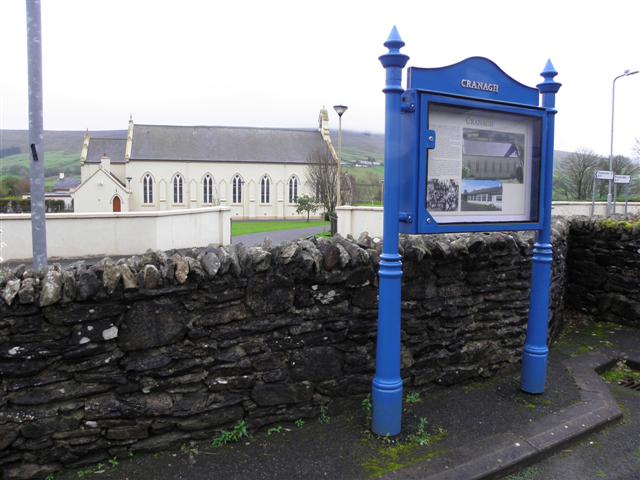Information board, Cranagh
Introduction
The photograph on this page of Information board, Cranagh by Kenneth Allen as part of the Geograph project.
The Geograph project started in 2005 with the aim of publishing, organising and preserving representative images for every square kilometre of Great Britain, Ireland and the Isle of Man.
There are currently over 7.5m images from over 14,400 individuals and you can help contribute to the project by visiting https://www.geograph.org.uk

Image: © Kenneth Allen Taken: 21 Oct 2011
The following text is included, "The village of Cranagh developed in the nineteenth century following the building of the chapel and the school but it has a far longer history of human habitation, dating from the Bronze Age or New Stone Age. The stone alignment at Oughboy may originally have been stone circles, possibly used for religious purposes in earlier times while the numerous ring forts in the district denotes a populated area in the early Christian period. The use of Irish as the spoken language of the people lasted up to the early 20th century and many traditional beliefs and expressions still survive. The first chapel was built in 1814 by Fr Patrick O'Mullan and replaced in 1912 on an adjacent site by the present structure when Fr McGoerty was parish priest and Fr Felix O'Neill was curate. The opening of a school led to the nucleus of a village and in 1825 it was reported that Barny Gormley had a stone and clay schoolhouse, built it a cost of £6 and catering for thirty three pupils; this was replaced in 1847 by a National school in the neighbouring townland of Legcloghfin (Legcloughfin National School, 1957). The school was replaced by St. Brigids Primary School in Cranagh Village, which opened in 1958. The opening of a shop and pub further ensured the growth of the village. Poteen making had long been a tradition in the area and it survived until well into the 1900s - some would say that it has not totally disappeared even yet. The development of a GAA club in the 1930s gave greater cohesion to the community while Cranagh Sports provided an annual opportunity for athletes and sportsmen for miles around to test their skills and endurance against each other and enabled young i old to come together on this festive occasion. Wakes and ceilidh houses continued for long to provide opportunities for story preserving local traditions and Cranagh even today retains a distinctiveness and sociability." See front view here Image]

